It seems the incredibly wet weather of the summer is not letting up as we approach the winter. I was hoping conditions were improving at the start of November. We had about 10 days without rain, long enough for the water butts to be close to empty. On a couple of mornings we even took water over to the allotment to ensure we had sufficient for the hens and ducks. And then the storms began again. We now have a huge amount of mud on the allotment and a stream running into one side of the duck pond and out the other side. This however is not as bad as it seems. The ducks had made quite a mess of the pond and we were planning to pump out the water and clean it out. The weather has flushed it out for us. Whilst the ducks are having a great time in the mud and damp conditions, the hens are not feeling so happy about it.
Attempts to plant anything at the moment are futile. We got our winter cabbages, some chard and half our onions planted towards the end of the dry spell this month. The other half of the onions are still waiting to go in. We are expecting dryer weather for the rest of this week but the ground is so wet that I doubt we will get them planted soon.
We grow our own food in a suburban village in the North East of England. Follow us as we keep up the battle to be self-sufficient.
Wednesday 28 November 2012
Wednesday 21 November 2012
Sweet mince
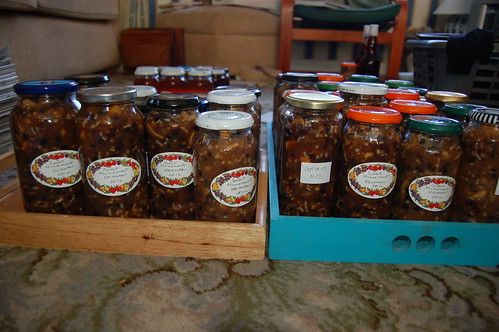
Autumn arrives and so does the need to make sweet mince. I have previously made a video about making sweet mince so I'm not going to talk about the whole of the recipe. I will however mention in passing the gin and vodka pickled fruit left over from making fruit liqueurs. I save it up and add it to the sweet mince. I am sometimes left with old jams and marmalades and jellies that have not set well (or at all!) so rather than waste them, they also find their way into the sweet mince as well.
As a result, I now have 37 jars of sweet mince. I will be making lots of pies and doing lots of swaps shortly.
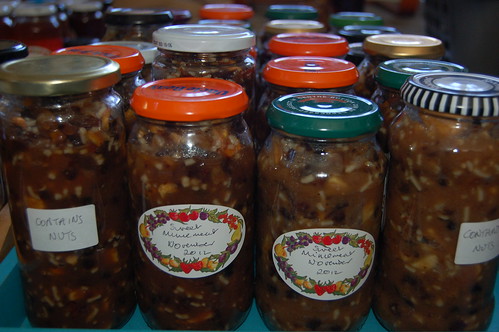
Making beetroot relish
Friday 16 November 2012
Another stash of hidden eggs
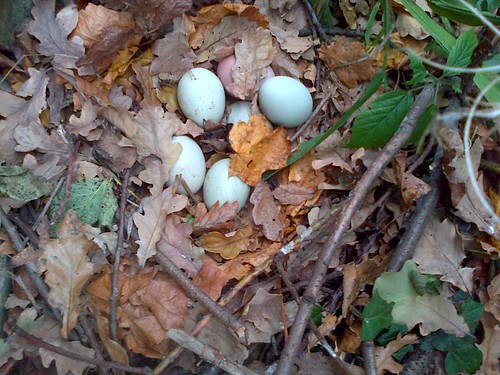
The number of eggs our hens have been producing recently has dropped. Some of this is down to the fact some are moulting but it is not enough to explain the full drop. For some days, there have been no green eggs, laid by my columbines. Today, when I opened up the henhouses, I spotted one of the columbines head to the tool cabinet on the allotment. I had a look behind it and there were 5 columbine eggs and one laid by one of our ambers. So that's that problem solved.
Meanwhile, I rather like the photo below I took this morning. Some of the hens are in the shelter we built for them earlier this year. It is meant to keep them dry when it rains - and we have had a vast amount of rain this year. Yet, for the past few weeks, we have experienced up here a relatively dry fortnight. The ground has dried out and the hens don't need to shelter from rain. Oddly, now is the time they decide to use it!

Thursday 15 November 2012
Victorian jam pan
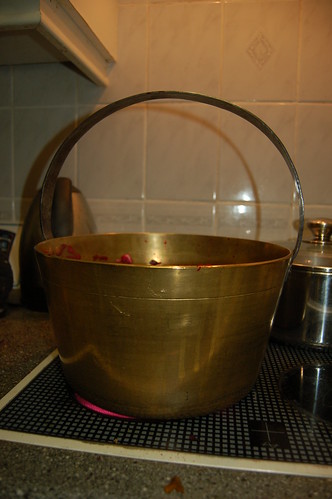
A number of readers and viewers of my videos have commented recently to me about my jam pan. So why should a pan be such a point of interest for a conversation? Well, it's because it is made of aluminium and some people have raised issues about the affect on health of this metal. So, in the pursuit of a healthy lifestyle, I have borrowed from Dad the jam pan with which I was taught to make jam. It is made of brass and is Victorian. My great grandmother Jessie Wallace was the first to use it over 120 years ago and it's been in the family every since. Tonight I used it to make beetroot relish (more on that later).
Monday 12 November 2012
Ash die-back disease
Another crisis looks set to ravish our woodlands. The UK media has been reporting extensively on ash die-back disease having been found here. Ash trees at a number of sites in the UK have been found to be suffering from the disease caused by a fungal infection (official name Chalara. Fraxinea) which has already struck woodlands in European countries such as Denmark and Poland. There are two possible routes the disease has travelled to arrive in the UK: airborne spores which have been blown across the North Sea and infected trees imported from Europe. Whatever the cause, we now have it here in the UK and we are in a situation in which we will have to manage it, rather than eradicate it.
Approximately one in three trees in UK woodlands is an ash. I have lots of them on the edge of my allotment and the ash keys from the nearby mature trees rain down on us leading to ash tree saplings growing like weeds. We are constantly having to get rid of them. My fear is that that will become a memory as the disease spreads across the UK.
Back in the 1970s we saw the loss of most of our Dutch elms in Britain. Dutch elm disease left its mark everywhere. Millions of trees fell victim. I still remember spotting the elm in the woodland behind our house beginning to suffer from the disease. The Council was called, they came out and one day I got back from school and found the wrong tree had been cut down. Sometime later, the correct tree was felled and burnt.
I never thought I would see the day when another of our common woodland species would be threatened with near total loss.
Judging from the messages, posts and emails I receive from readers of this blog, I know many of you live in central and eastern Europe. If your area has suffered from ash die-back, post up a comment to tell me what happened and what the effects were. You can also email me – jonathanwallace@compuserve.com.
Approximately one in three trees in UK woodlands is an ash. I have lots of them on the edge of my allotment and the ash keys from the nearby mature trees rain down on us leading to ash tree saplings growing like weeds. We are constantly having to get rid of them. My fear is that that will become a memory as the disease spreads across the UK.
Back in the 1970s we saw the loss of most of our Dutch elms in Britain. Dutch elm disease left its mark everywhere. Millions of trees fell victim. I still remember spotting the elm in the woodland behind our house beginning to suffer from the disease. The Council was called, they came out and one day I got back from school and found the wrong tree had been cut down. Sometime later, the correct tree was felled and burnt.
I never thought I would see the day when another of our common woodland species would be threatened with near total loss.
Judging from the messages, posts and emails I receive from readers of this blog, I know many of you live in central and eastern Europe. If your area has suffered from ash die-back, post up a comment to tell me what happened and what the effects were. You can also email me – jonathanwallace@compuserve.com.
Feeding the bees
We fed all 8 of our hives yesterday with fondant. We used something called "Fondabee". Instead of coming in a 12.5kg block that needs to be cut up into smaller chunks, Fondabee comes in 2.5kg blocks, each one ready wrapped. And to add to that, a section of the wrapping can be easily stripped off. This is a considerable improvement on the old system of chopping off a chunk of fondant, putting it into a plastic bag and then ripping open part of the bag to allow the bees to get to the fondant. My guess is that Fondabee has been invented by someone who is a beekeeper.
I have to confess that I am not a fan of the way commercial products are packaged. The packaging is excessive and eats up important resources which then enter our waste stream. Dealing with packaging is one of the biggest headaches for those responsible for disposing of waste. Something I have noticed since we started to go down the road of self-sufficiency is the big reduction in waste we put out for collection. Nevertheless, the way Fondabee is packaged is progress.
We did not do proper inspections of the hives but we got a good impression of their health. 6 of the hives are fine. 2 need to be watched closely. They could be candidates for merging with other hives in the new year.
I have to confess that I am not a fan of the way commercial products are packaged. The packaging is excessive and eats up important resources which then enter our waste stream. Dealing with packaging is one of the biggest headaches for those responsible for disposing of waste. Something I have noticed since we started to go down the road of self-sufficiency is the big reduction in waste we put out for collection. Nevertheless, the way Fondabee is packaged is progress.
We did not do proper inspections of the hives but we got a good impression of their health. 6 of the hives are fine. 2 need to be watched closely. They could be candidates for merging with other hives in the new year.
Wednesday 7 November 2012
Duck scotch eggs

We are now getting two eggs a day from our ducks. So far, I've made a couple of sponge cakes and 6 scotch eggs with them. Today I poached one. The scotch egg recipe is no different to the one I use when making them using hen eggs. I have to confess that the sausage meat we used did not come from our Tamworth pig. One of the reasons for making the scotch eggs was to use up some sausage meat we have bought some time ago and put in the freezer. We wanted it used up before we start making inroads into the significant quantity of Tamworth sausage meat now in our freezer.
Making runner bean chutney
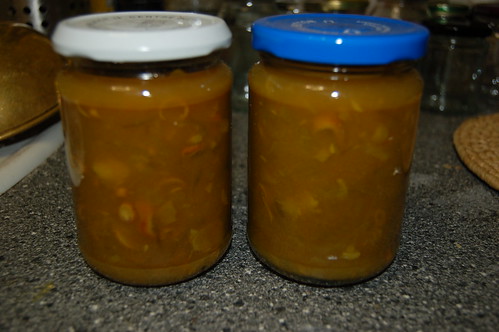
The last of the runner bean crop is now harvested and so we are faced with choices of how to preserve them. We have, in past years, frozen and salted them. This year we have frozen most but put some aside to make runner bean chutney.
Here is the recipe I used over the weekend:
- 1kg sliced runner beans
- 750g chopped onions
- 900ml cider vinegar
- 45g cornflour
- 1 heaped tbsp mustard powder
- 1 level tbsp turmeric
- 700g soft brown sugar
Whilst the simmering is taking place, mix the cornflour, turmeric and mustard with a bit of vinegar to make a paste. Add this to the pan with the onions and runner beans. Pour in the rest of the vinegar and simmer for 10 minutes. Then add the sugar and simmer for a further 15 minutes.
Add to warm sterilised jars.
There are two waste products from this recipe that can be used elsewhere. The water in which the beans were boiled can be saved to make a stock. I've just made bacon and vegetable soup using this stock. And the top and tail of the runner beans, and the stringy edges, all of which are removed before the beans are chopped, can also be used to make stock as well.
In other words, waste nothing.
Sunday 4 November 2012
Tamworth pig update
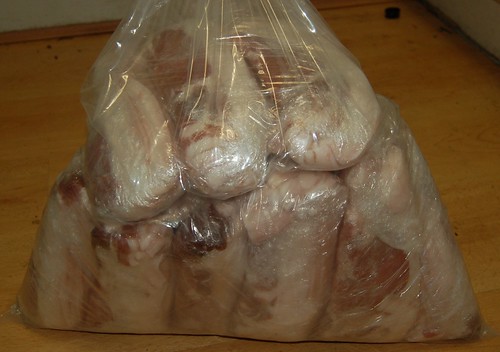
We have now got the bacon back from the butchers from our Tamworth pig. We picked it up yesterday and last night we had our first meal using the bacon - the classic British breakfast meal bacon and eggs though we were having it for our evening dinner. The eggs were our own as well.
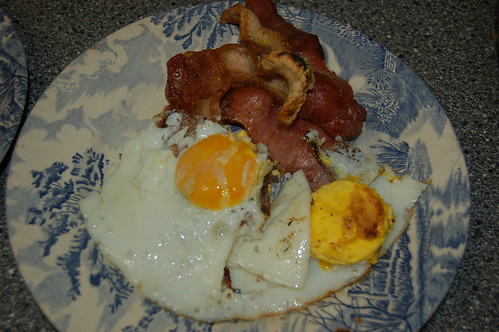
The Tamworth is quite an old breed, predating the modern, commercial breeds and therefore the meat is considered to be much closer to the original forest-dwelling wild swine from which domesticated breeds are descended.

The flavour of the bacon was superb and there was a good layer of rind which grilled to a beautifully crisp texture.
The leg joint we roasted last weekend has now been fully used. The meat left over from the Sunday roast went into a pork and vegetable soup which we consumed through the week. The bone has gone into the freezer and at some point will be used to make more stock.
Alas, our cat has decided not to share our enthusiasm for the Tamworth. We cooked her some lung. She ate half of it and then refused to touch the rest. We tried to give her some more freshly cooked lung but she wasn't having it. What we had cooked for her ended up going into making the stock for the soup. If anyone has any recipes for pig lung, please send them! Pushka is now back on to Whiskas, not exactly part of our plan to become self-sufficient, though she did rather like the bits of the leg joint we gave her!

Friday 2 November 2012
High in a hedge
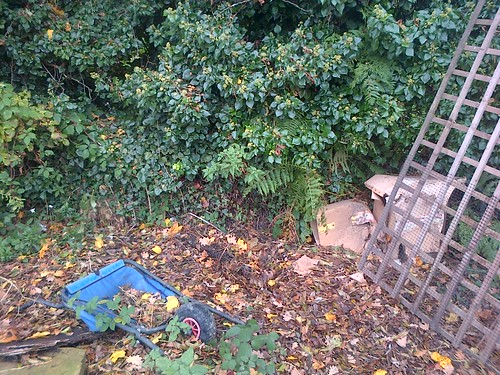
Yesterday I wrote that the productivity of our hens had gone down recently. I put some of this down to hens moulting and the seasons. Well, this morning, I noticed one of my hens emerge from the ivy hedge next to the entrance to the chicken run. Curiosity got the better of me so I took a look at where she had been and found this:
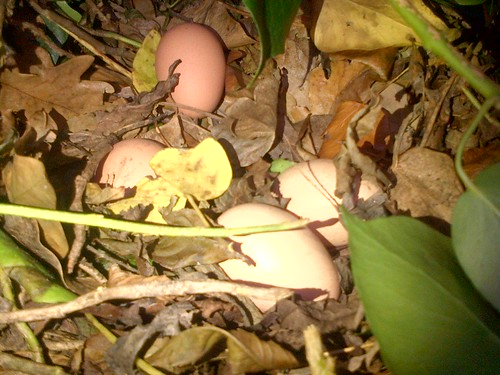
A hens' nest containing 4 eggs. It doesn't explain the whole reason for the drop in egg output and maybe I need to check other hedges, however, it does partly explain why previously it appeared that 14 hens were producing only 7 eggs a day.
Thursday 1 November 2012
A second duck starts laying
About three weeks ago, one of my khaki campbell ducks started laying. Since then she has laid every day except once. Today, the second khaki produced an egg. If she is anything like the other, we will have quite a supply of duck eggs. I used six of the eggs this evening to make scotch eggs. They will do for lunches for the next few days.
The 4 ducklings are growing fast. Actually it's a bit inaccurate to call them ducklings. 3 of them (the aylesbury, runner and magpie) are now fully grown. The 4th (another khaki) is not far behind. As yet, we still don't know what sex they are.
Productivity from the hens however has gone down. We have only 14 now but are averaging only 7 eggs a day. At least two are moulting which partly explains the drop in the number of eggs. The columbines have stopped laying their lovely green eggs. Maybe they are more seasonal in their laying habits.
The 4 ducklings are growing fast. Actually it's a bit inaccurate to call them ducklings. 3 of them (the aylesbury, runner and magpie) are now fully grown. The 4th (another khaki) is not far behind. As yet, we still don't know what sex they are.
Productivity from the hens however has gone down. We have only 14 now but are averaging only 7 eggs a day. At least two are moulting which partly explains the drop in the number of eggs. The columbines have stopped laying their lovely green eggs. Maybe they are more seasonal in their laying habits.
Subscribe to:
Posts (Atom)

